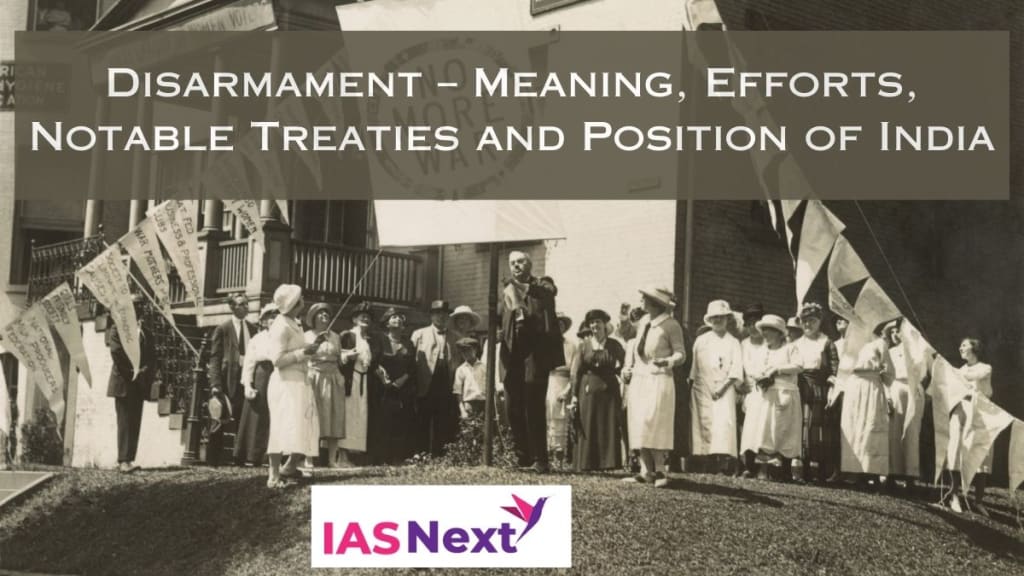Disarmament – Meaning, Efforts, Notable Treaties and Position of India
IAS NEXT is a topmost Coaching Institute offering guidance for Civil & Judicial services like UPSC, State PCS, PCS-J exams since more than 10 years.

Introduction
Disarmament in the broad sense means the total abolition of armaments of all types – conventional as well as nuclear. It is different from regulation of armaments which means reduction and restriction of armaments. The desire for the total ban on armaments has been expressed time and again since the beginning of the 20th century, but its intensity began to grow only after the Second World War. With the use of atom bombs in Hiroshima and Nagasaki, the question of disarmament assumed new dimensions. The problem of disarmament is not only legal but is also economic, political, military and technical. Its legal aspect became significant with the efforts of the United Nations for the formulation of comprehensive international conventions.
UN and the Regulation of Armaments provisions of the Charter
One of the main purposes behind the establishment of the UN was the maintenance of peace and security. It advocates disarmament as one of the ways of achieving its goals. Article 11 of the UN Charter entrusts the General Assembly to consider the general principles governing disarmament and regulation of armaments and to make recommendations in this regard to members or the SC or both. Article 26 makes the Security Council responsible for plans to be submitted to the members and establish a system for the reduction of armaments. Article 47 refers to the functions of the Military Staff Committee, which is to assist and advise the Security Council’s military requirements including the regulation of armaments and possibly disarmament.
The above provisions do not confer final authority of the UN. It cannot impose the rule of disarmament on states and the provisions of disarmament are too weak. Further, it is possible to achieve armament faster than disarmament.
The UN Charter does not define the term “disarmament”. The process of disarmament is not consistent with the UN Charter. However, some weapons have been banned outright such as banning the testing of nuclear weapons, restrictions on armaments, chemical weapons treaty, poly weapons etc. while some are on the agenda such as nuclear weapons and land mines.
These provisions have been interpreted by jurists differently. Some are of the view that the UN Charter does not confer authority on the UN to impose upon its members a system for disarmament or even regulation of armaments.
The UN has assigned the matter of disarmament to the General Assembly. It approved its Resolution in 1946 which included among its goals, “the elimination of the national armaments of atomic weapons and all other major weapons adaptable to mass destruction. While Refugee Law recognizes certain narrowly defined exceptions to the principle of non-refoulement, the principle is absolute under other bodies of law.
Disarmament Efforts made by Institutional Machinery
1. In 1946 the Atomic Energy Commission was established by the General Assembly for submission of proposals to the Security Council regarding the peaceful use of atomic energy and for the elimination of atomic and other weapons of mass destruction.
2. In 1947 the Commission for Conventional Armaments was established by the Security Council to consider measures for the reduction of armaments and armed forces, together with an effective system of guarantee.
3. In 1952 both the Commissions were dissolved and were replaced by the Disarmament Commission, established by the General Assembly. It consisted of the members of the Security Council and Canada. Their purpose was to prepare proposals for the regulation, limitation and balanced reduction in stages of all armed forces and all armaments.
4. In 1957 and 1958, the Commission was enlarged; the latter included all member states of the UN. However, after this, only 2 sessions were held in 1960 and 1965........Read more
Read Also: Principle of Non-Refoulement
About the Creator
Enjoyed the story? Support the Creator.
Subscribe for free to receive all their stories in your feed. You could also pledge your support or give them a one-off tip, letting them know you appreciate their work.





Comments
There are no comments for this story
Be the first to respond and start the conversation.